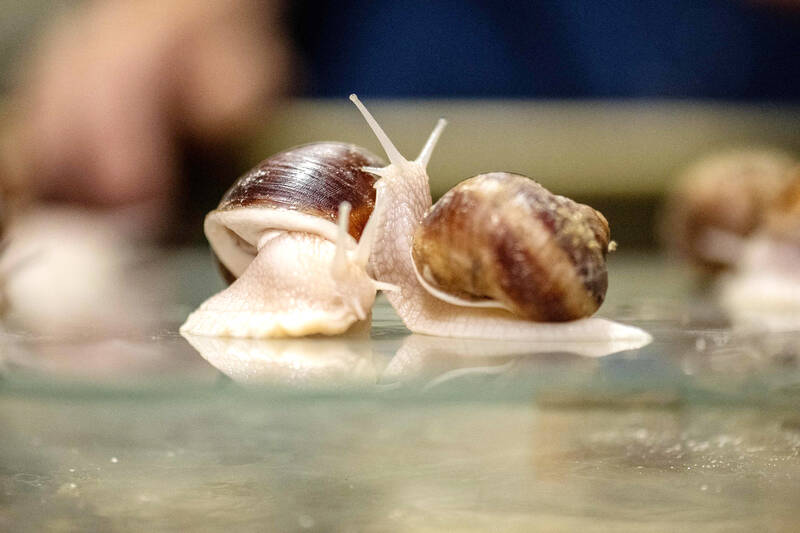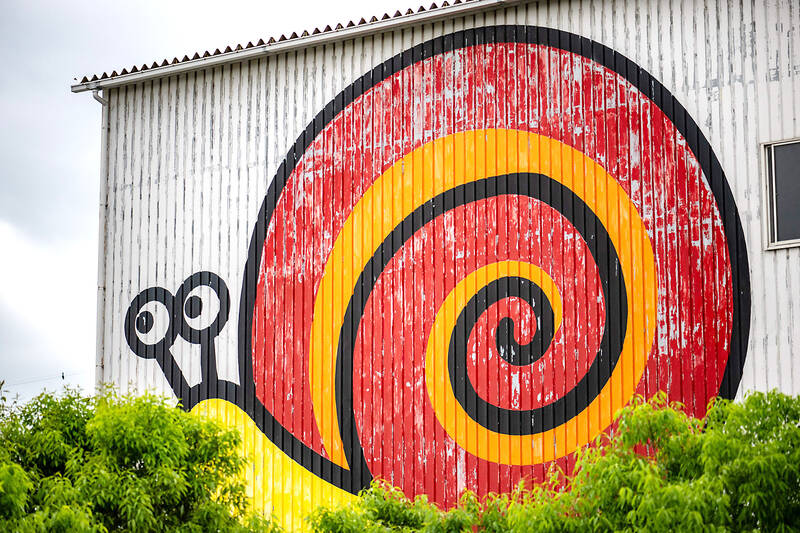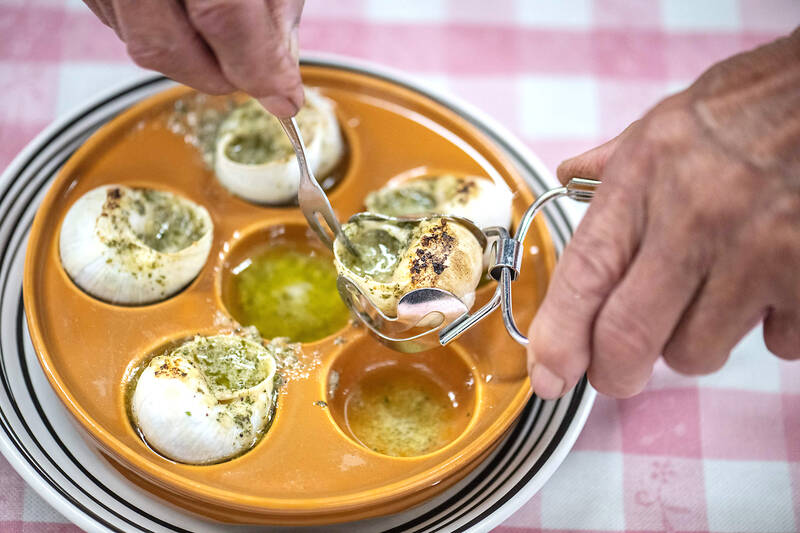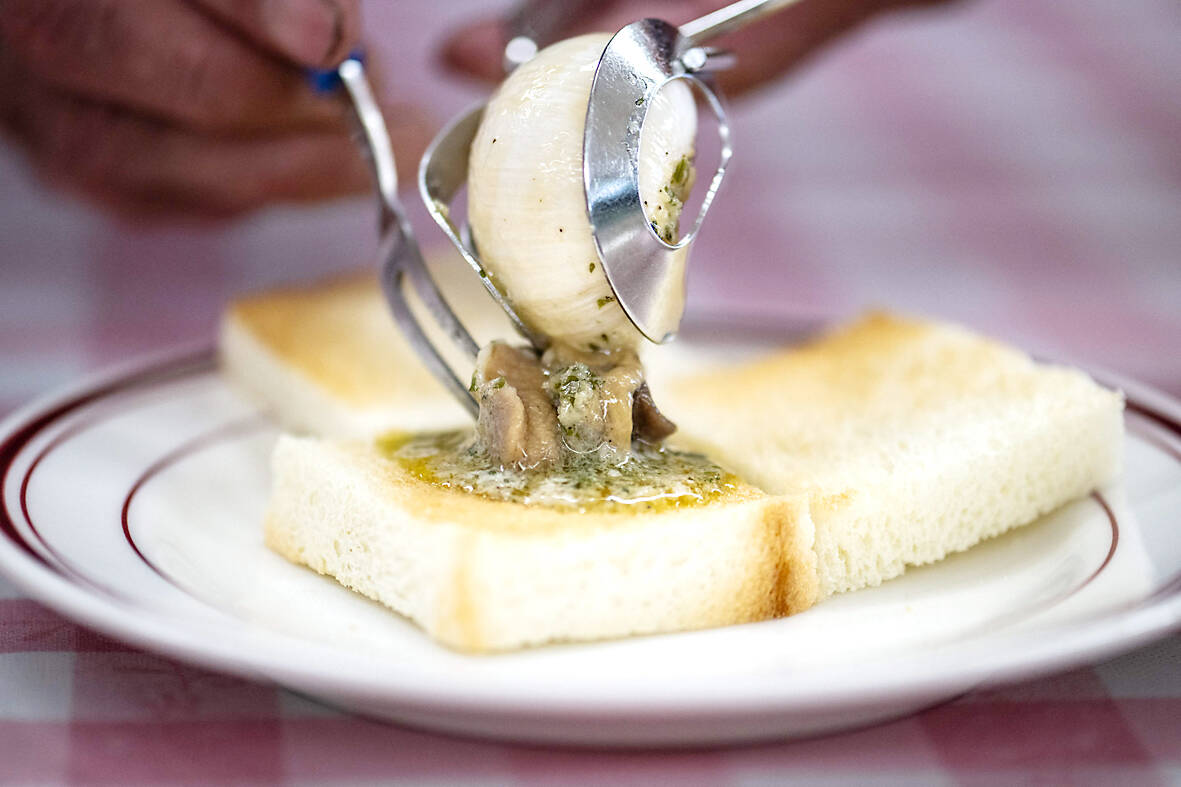Far from Parisian bistros serving up Burgundy snails, one Japanese man has figured out how to farm the slimy species — a feat that has long eluded the French.
Toshihide Takase, 76, says he is “the only person in the world” breeding this specific delicacy after four decades of trial and error to find the right conditions.
French embassy and industry insiders also believe that Takase, who has invested a small fortune and taught himself everything about the creature, is a unique case.

Photo: AFP
Stuffed with butter, garlic and parsley then baked, Burgundy snails — or escargots de Bourgogne — have been part of French gastronomy since the 19th century.
But they are notoriously difficult to farm because they don’t take well to crowded conditions and grow slowly, usually taking two or three years to reach adult size.
The mollusk, whose scientific name is helix pomatia, has been a protected species in France since 1979 to save it from extinction.

Photo: AFP
The vast majority of the several thousand tons of snails eaten by the nation each year are foraged from woodlands in central and eastern Europe.
Around five percent are homegrown in France, but these are a different species, helix aspersa, which are easier to farm and do not have the “Burgundy” name.
“My sister gave me tinned escargots as a present after a trip to France” 45 years ago, Takase said.

Photo: AFP
“But they didn’t taste good, and smelled bad,” said the retired entrepreneur.
Takase became obsessed with producing them himself, even though “at first, everybody acted like I was stupid.”
PERFECT CONDITIONS

Photo: AFP
He stubbornly devoured books on the subject and met French helix aspersa breeders to learn more.
It’s a niche interest anywhere, but highly unusual in Japan, where sea snails are part of the rich cuisine but land snails are seen as a pest that can harm crops.
After seven years of bureaucratic wrangling, Takase was granted a permit to rear helix pomatia and imported 100 specimens from France to start his farm.
The indoor facility in Matsusaka, a town between Osaka and Nagoya, is called the Mie Escargots Development Laboratory.
Crates of live Burgundy snails are stacked in three layers on custom-built metal racks, with humidity and temperature carefully controlled.
Next door is an active metalwork foundry — the first business set up by Takase, who used to manage several ventures.
He says the farm can produce up to 600,000 snails a year, with growth time reduced to just four months.
To achieve this, he adds a calcium-rich powder made from oyster shells to the humid soil, which helps the gastropods grow big and strong fast.
“They love it,” said Takase, who spent 20 years developing his own nutritious snail food from soybeans and corn.
Their feeding containers are washed by hand every three days, because “snails love cleanliness,” he added.
‘AT WHAT PRICE?’
Visitors to the “laboratory” get the chance to taste Takase’s snails, which cost 9,900 yen (US$60) for a pack of 30. There are different prices for restaurants or bulk sales.
For now, business is small-scale and domestic, but he is keen to pass on his know-how to French snail farmers and has launched talks with the embassy in Japan.
William Blanche, co-president of France’s National Federation of Heliciculture, said the species has a “reputation for being impossible to breed.”
It’s “ironic” that Burgundy snails eaten in France have been nowhere near the province of the same name, he said, so is intrigued by Takase’s project.
Even so, Blanche questioned how successful it could be.
“Would our consumers, who are used to different snails, be interested — and at what price?”
A French snail industry insider, who spoke on condition of anonymity, also raised an all-important point.
“They must taste good,” he said, skeptical that farmed Burgundy snails would be as delicious as wild ones with their “strong woodland taste.”
But “I dream of one day seeing escargots de Bourgogne made in France,” he added. “The marketing buzz would be huge.”

The Democratic Progressive Party (DPP), Chinese Nationalist Party (KMT), and the country’s other political groups dare not offend religious groups, says Chen Lih-ming (陳立民), founder of the Taiwan Anti-Religion Alliance (台灣反宗教者聯盟). “It’s the same in other democracies, of course, but because political struggles in Taiwan are extraordinarily fierce, you’ll see candidates visiting several temples each day ahead of elections. That adds impetus to religion here,” says the retired college lecturer. In Japan’s most recent election, the Liberal Democratic Party lost many votes because of its ties to the Unification Church (“the Moonies”). Chen contrasts the progress made by anti-religion movements in

Last week the State Department made several small changes to its Web information on Taiwan. First, it removed a statement saying that the US “does not support Taiwan independence.” The current statement now reads: “We oppose any unilateral changes to the status quo from either side. We expect cross-strait differences to be resolved by peaceful means, free from coercion, in a manner acceptable to the people on both sides of the Strait.” In 2022 the administration of Joe Biden also removed that verbiage, but after a month of pressure from the People’s Republic of China (PRC), reinstated it. The American

Chinese Nationalist Party (KMT) legislative caucus convener Fu Kun-chi (傅?萁) and some in the deep blue camp seem determined to ensure many of the recall campaigns against their lawmakers succeed. Widely known as the “King of Hualien,” Fu also appears to have become the king of the KMT. In theory, Legislative Speaker Han Kuo-yu (韓國瑜) outranks him, but Han is supposed to be even-handed in negotiations between party caucuses — the Democratic Progressive Party (DPP) says he is not — and Fu has been outright ignoring Han. Party Chairman Eric Chu (朱立倫) isn’t taking the lead on anything while Fu

Feb 24 to March 2 It’s said that the entire nation came to a standstill every time The Scholar Swordsman (雲州大儒俠) appeared on television. Children skipped school, farmers left the fields and workers went home to watch their hero Shih Yen-wen (史艷文) rid the world of evil in the 30-minute daily glove puppetry show. Even those who didn’t speak Hoklo (commonly known as Taiwanese) were hooked. Running from March 2, 1970 until the government banned it in 1974, the show made Shih a household name and breathed new life into the faltering traditional puppetry industry. It wasn’t the first